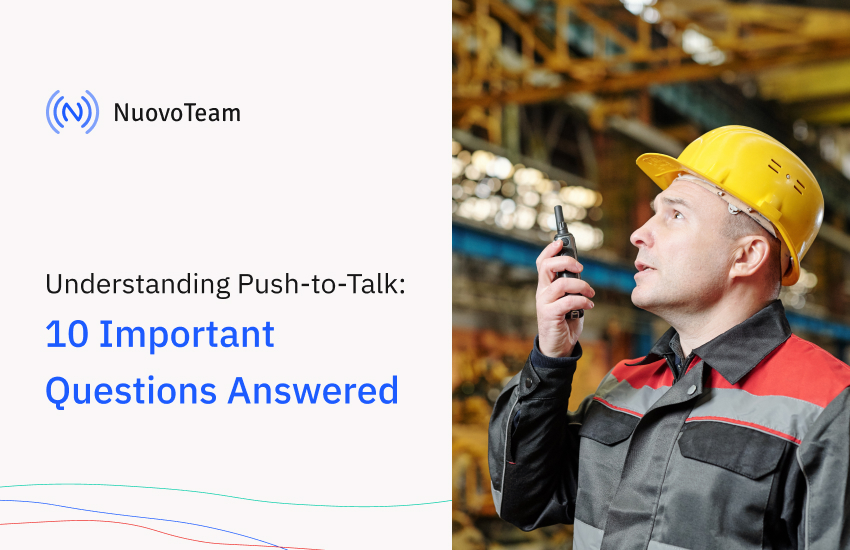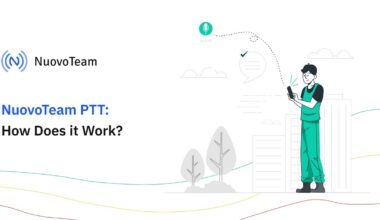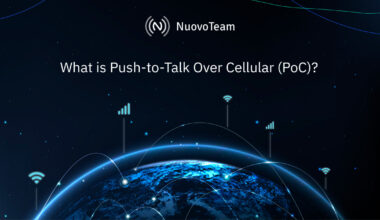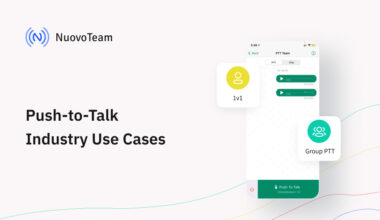Field and frontline communication are nowhere close to office communication. Then why must the modes of communication be the same for both? Push-to-Talk is a familiar concept for businesses that have a field workforce. It is faster and safer when it comes to keeping the field workforce connected with their team members and office staff. However, push-to-talk has evolved with time and we now have Push-to-talk services that offer more secure connectivity on a global scale.
Here are 10 questions that will bring you to date with push-to-talk.
Top 10 Questions About Push-to-Talk (PTT) Answered
1. What is PTT?
Push-to-Talk is a half-duplex communication mode used in popular two-way radio devices such as walkie-talkies. It allows users to communicate with the press-button transmission using handheld devices. Invented in the early 1900s, traditionally the PTT technology was designed to be used over radio frequencies to help the field workforce and frontline teams communicate with their on-site team members.
2. How does PTT work?
Push-to-Talk works on the half-duplex mechanism, meaning that users can communicate bi-directionally, but one at a time. Unlike the full duplex communication used by cellular phone calls, in which users can talk to each other simultaneously, push-to-talk devices such as walkie-talkies and land mobile radios (LMRs) allow only one person to talk at a time. Traditionally this PTT communication was leveraged using radio networks. Now, modern-day forms of PTT communication use cellular networks and Voice over internet protocol (VoIP) to establish PTT connectivity.
3. Does PTT still exist?
Push-to-Talk is one of the fastest modes of communication that helps several industries where quick connectivity is critical. Although Push-to-Talk radios like walkie-talkie radios and land mobile radios have failed to evolve with time and are rarely used today, Push-to-Talk technology is far from being obsolete. With advances in technology, the PTT functionality has been added to several other devices including smartphones. We now have PTT apps such as NuovoTeam which can be downloaded on the users’ smartphones to leverage push-button connectivity over cellular networks.
Know all about PTT apps: https://blog.nuovoteam.com/what-is-a-push-to-talk-app-a-fundamental-elaboration/
4. Why have PTT radios disappeared?
There were times when two-way radios that delivered push-button radio connectivity were largely used by field workers to stay communicated with their on-site teams. However, today we live in a mobile-first world with new and better technologies arriving every day, such as the 5G network. Today, businesses focus on operational excellence and customer satisfaction. Keeping these factors in mind, radio communication just does not fit in today’s world. It presents several barriers to seamless communication such as limited frequency range, low audio quality and lack of security. It is safe to say that radios are a thing of the past and several businesses now are preferring cellular connectivity over radio networks.
5. What is Push-to-Talk over cellular (PoC)?
Push-to-Talk over cellular is a modern-day alternative to two-way radios. As the name suggests, push-to-talk over cellular or PoC offers users push-button connectivity over cellular networks. With this, users can leverage ultra-fast PTT connectivity straight from their smartphones over 3G, 4G, 5G or WiFi networks. PTT over cellular offers nationwide or global coverage, unlike radio-based PTT devices which offer connectivity over a limited area. Today’s field businesses experience immense benefits with PTT over cellular, as they can stay connected with their teams from anywhere in the world.
6. Can a smartphone be used as a walkie-talkie?
There are powerful Push-to-talk apps such as NuovoTeam available in the market today that allow users to leverage PTT over cellular networks. With this, enterprises do not need to invest in purchasing dedicated handsets or worry about radio communication licenses. Simply installing an efficient PTT app on the users’ smartphones can help turn the device into a walkie-talkie.
7. Why use PTT apps?
Field workforce or frontline employees operate from remote environments and are constantly on the move. The push-to-talk mechanism is devoid of complex direct dialing or messaging procedures. With modern-day PTT apps integrated into smartphones, all that the users have to do is press a single button to obtain both, one-to-one or group connectivity. This is beneficial for field communication since various teams can communicate instantly from anywhere in the world, and line managers and supervisors can keep their employees engaged throughout.
Besides, modern-day PTT apps extend a comprehensive range of features for the users such as;
- Video and multi-media messaging
- Text messaging
- File sharing
- Location sharing
- Corporate directory integration
- Channel management for group calls
- MDM integration
- Encrypted connection
8. PTT is ideal for which industries?
Push-to-talk has been immensely popular for businesses that have a field workforce. You may have seen several field employees such as construction workers, mine workers, etc. use walkie-talkies to stay connected with their fellow colleagues. Push-to-talk apps simplify field communication even further and remove the limitations of radio communication.
Push-to-talk apps are ideal for the field workforce and frontline workers belonging to the following industries:
- Construction
- Mining
- Logistics & Transportation
- Manufacturing
- Warehousing
- Retail
- Hospitality
- Security services
- Emergency services
9. Is PTT secure?
Radio communications are not very secure since radio frequencies are generally shared by multiple users. When it comes to relaying sensitive business information, there are chances of corporate data leakage over radio communication. However, modern-day PTT connects users over cellular frequencies which are generally secured with either 128-bit or 256-bit encryptions. This makes it complex for hackers to intrude on secure communications.
Moreover, powerful PTT apps like NuovoTeam understand that privacy is critical when it comes to corporate communications, hence it offers 128-bit encryption for all the communication made from the software.
10. Can PTT connect your office staff to your field workforce?
As PTT apps gain traction worldwide, they are being developed in a way to help field businesses streamline their communications effortlessly. Push-to-talk services such as NuovoTeam offer desktop PTT functionality which enables the office staff to make PTT calls from their PCs, macOS or Linux machines. This means that employees working from offices need not toggle between their desktops and smartphones just to make PTT calls. They can stay seamlessly connected with their field workforce straight from their desktops.
Closing Lines
Radio communication may slowly be turning obsolete, but push-to-talk is here to stay. Comprehensive PTT apps like NuovoTeam help your business improve its operational efficiency and improve its revenue. If you have a field workforce and wish to streamline your field communication in the most efficient way, the NuovoTeam PTT app is just what you need.






